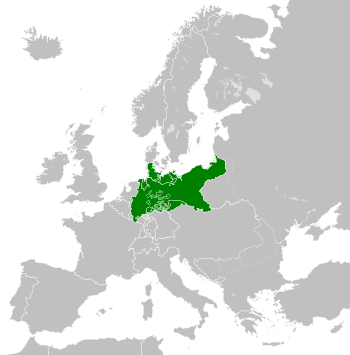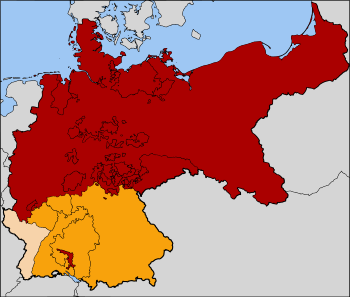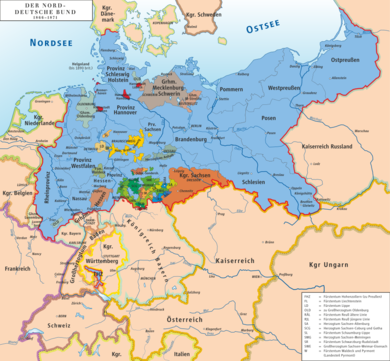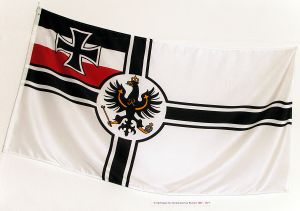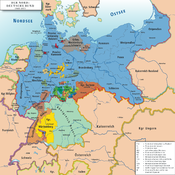الكونفدرالية الألمانية الشمالية
| ||||||||||||||||||||||||||||||||||||||||||||||||||||||||||||||||||
الكونفدرالية الألمانية الشمالية (ألمانية: Norddeutscher Bund[1]) was a confederation of 22 previously independent states of northern Germany, with nearly 30 million inhabitants. It was the first modern German nation state and the basis for the later الامبراطورية الألمانية (1871–1918), when several south German states such as باڤاريا joined.
After several unsuccessful proposals from several sides to reform the German Confederation (founded in 1815), the North German major power Prussia left the German Confederation with some allies. It came to war between those states on one hand and southern states led by Austria on the other. After a quick decision in the Austro-Prussian War of July 1866, Prussia and its allies founded the North German Confederation. At first, it was a military alliance between independent states, the so-called August Alliance (August-Bündnis), but the states already had the intention to form a federation or confederation with a constitution. This was realised in 1867. The North German Confederation is historically important for the economic and judicial unification of Germany; many of its laws were taken over by the German Empire.
The North German Confederation continues as the German nation state which still exists today. On January 1st, 1871, the country received a new constitution that gave it the name 'German Empire'.
التاريخ
الحرب الألمانية وآثارها
في الحرب الألمانية سنة 1866، انتصرت پروسيا وحلفاؤها على النمسا ومملكة باڤاريا وWurttemberg, Saxony and Hanover, as well as other states such as Baden and the Grand Duchy of Hesse . In the pre-eminence with Austria (July 26), Prussia secured permission to rearrange the situation in the north of Germany to the main line . The expression " North-German Confederation" appears first . Prussia had previously arranged this arrangement with France's Emperor Napoleon III. Voted.
معاهدات أغسطس ورايخستاگ الممثلين
 مقالة مفصلة: معاهدة الكونفدرالية الألمانية الشمالية
مقالة مفصلة: معاهدة الكونفدرالية الألمانية الشمالية
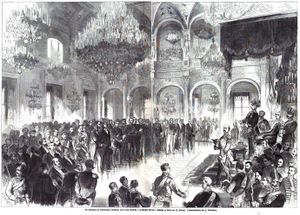
حتى دستور 1867
ثلاث سنوات من التشريع
The constitution opened the Confederation for the south German states to join. But in the situation of 1866/1867, France would not have accepted such an enlargement of Prussia's power. Bismarck, shortly after the war with Austria and amid negotiations about the constitution, could not afford a military conflict with France.[2]
During the roughly four years of the North German Confederation its major action existed in legislation unifying Northern Germany. The Reichstag decided on laws concerning (e.g.):
- free movement of the citizens within the territory of the Confederation (1867)
- a common postal system (1867/1868)
- common passports (1867)
- Prussian military laws replacing local military regulation (1867)
- equal rights for the different denominations (1869)
The North German Confederation became a member of the Zollverein, the German customs union of 1834. After negotiations in 1867, on 1 January 1868 it was transformed to a closer organisation with new institutions: a council for the governments and a parliament. Bismarck hoped that the Zollverein might become the vehicle of German unification. But in the 1868 Zollverein elections the South Germans voted mainly for anti-Prussian parties.
الامبراطورية الألمانية
النظام السياسي
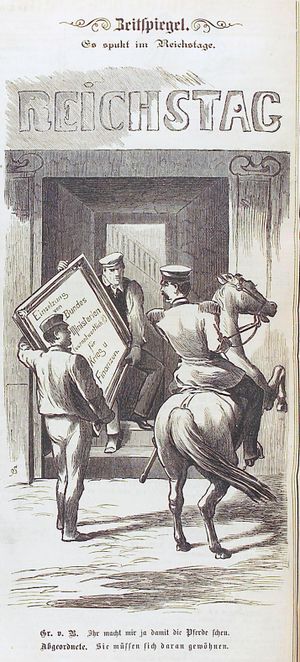
The North German Constitution of 16 April 1867 created a national parliament with universal suffrage (for men above the age of 25), the Reichstag. Another important organ was the Bundesrat, the 'federal council' of the representatives of the allied governments. To adopt a law, a majority in the Reichstag and in the Bundesrat was necessary. This gave the allied governments, meaning the states and their princes, an important veto.
السياسة الخارجية
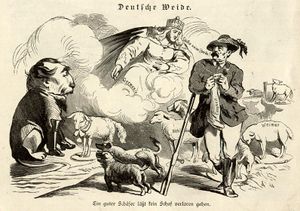
الحرب الألمانية الفرنسية
 مقالة مفصلة: الحرب الألمانية الفرنسية
مقالة مفصلة: الحرب الألمانية الفرنسية
الطوابع البريدية
One of the functions of the confederation was to handle mail and issue postage stamps; for details, see postage stamps and postal history of the North German Confederation.
قائمة الدول الأعضاء

| الولاية | العاصمة | |
|---|---|---|
| الممالك (Königreiche) | ||
| پروسيا (Preußen) (بما فيها لاونبورگ) |
برلين | |
| ساكسونيا (Sachsen) | درسدن | |
| الگراندوقيات (Großherzogtümer) | ||
| Hesse (Hessen) (Only Upper Hesse, the province north of the نهر ماين) |
Giessen | |
| Mecklenburg-Schwerin | Schwerin | |
| Mecklenburg-Strelitz | Neustrelitz | |
| اولدنبورگ | اولدنبورگ | |
| زاكسه-ڤايمار-آيزناخ (Sachsen-Weimar-Eisenach) | ڤايمار | |
| الدوقيات (Herzogtümer) | ||
| آنهالت | دساو | |
| برونزويك (Braunschweig) | براونشڤايگ | |
| Saxe-Altenburg (Sachsen-Altenburg) | Altenburg | |
| Saxe-Coburg and Gotha (Sachsen-Coburg und Gotha) | Coburg | |
| Saxe-Meiningen (Sachsen-Meiningen) | Meiningen | |
| الإمارات (Fürstentümer) | ||
| ليپه | دتمولد | |
| Reuss, junior line | گـِرا | |
| Reuss, senior line | Greiz | |
| Schaumburg-Lippe | Bückeburg | |
| Schwarzburg-Rudolstadt | Rudolstadt | |
| Schwarzburg-Sondershausen | Sondershausen | |
| Waldeck-Pyrmont | Arolsen | |
| المدن الهانزية الحرة (Freie Hansestädte) | ||
| برمن | ||
| هامبورگ | ||
| لوبك | ||
انظر أيضاً
References
- ^ An alternative translation is "North German Federation."
- ^ Görtemaker, Manfred (1983). Deutschland im 19. Jahrhundert: Entwicklungslinien. Opladen. p. 241.
{{cite book}}: CS1 maint: location missing publisher (link)
Further reading
- Craig, Gordon A. Germany, 1866–1945 (1978) pp 11-22 online edition
- Holborn, Hajo. A History of Modern Germany: 1840–1945 (1969) pp. 173–232
- Hudson, Richard. "The Formation of the North German Confederation." Political Science Quarterly (1891) 6#3 pp: 424-438. in JSTOR
- Nipperdey, Thomas. Germany from Napoleon to Bismarck: 1800-1866 (1996), very dense coverage of every aspect of German society, economy and government
- Pflanze, Otto. Bismarck and the Development of Germany, Vol. 1: The Period of Unification, 1815–1871 (1971)
- Taylor, A.J.P. Bismarck: The Man and the Statesman (1967) online edition
- CS1 maint: location missing publisher
- Pages using gadget WikiMiniAtlas
- Pages using infobox country with unknown parameters
- Pages using infobox country or infobox former country with the symbol caption or type parameters
- Articles containing ألمانية-language text
- Pages using Lang-xx templates
- Coordinates on Wikidata
- North German Confederation
- Modern history of Germany
- 1860s in Germany
- 1870s in Germany
- Former confederations
- مملكة پروسيا
- دول وأقاليم تأسست في 1867
- States and territories disestablished in 1871
- 1867 establishments in Germany
- 1871 disestablishments in Germany
- 1867 establishments in Europe


